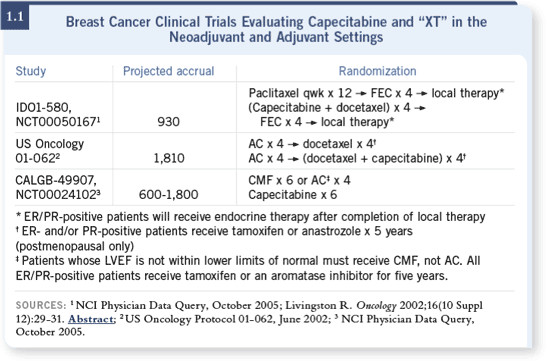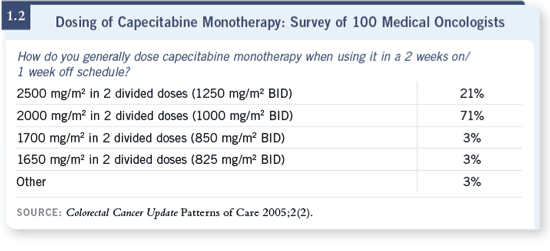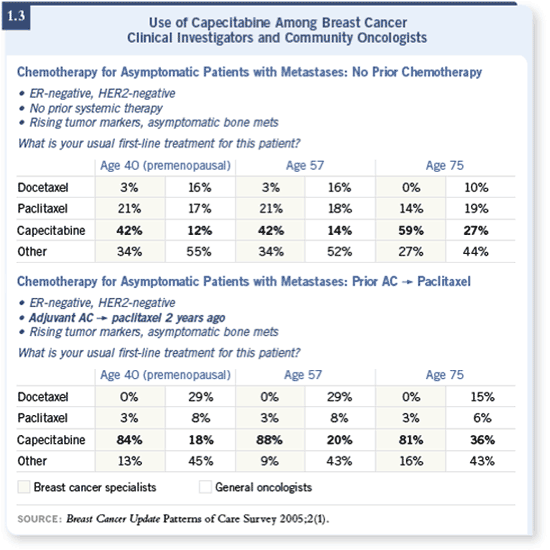
 DR LOVE: Do you feel that you’re compromising the utility of
capecitabine as monotherapy in metastatic breast cancer by reducing the
dose below the package insert level? DR LOVE: Do you feel that you’re compromising the utility of
capecitabine as monotherapy in metastatic breast cancer by reducing the
dose below the package insert level?
 DR VALERO: I personally do not. I believe that by lowering the dose, we
are delivering a therapy that has a better therapeutic index, particularly
when we remember that this is palliative chemotherapy. DR VALERO: I personally do not. I believe that by lowering the dose, we
are delivering a therapy that has a better therapeutic index, particularly
when we remember that this is palliative chemotherapy.
In my opinion, some of our traditional methods to develop drugs in the
metastatic setting haven’t been optimal, because we increased the dose
until the patients were as sick as tolerable to determine the maximum
tolerated dose (MTD). If I were a patient and understood that the disease
won’t be cured, I would want to be able to receive more cycles at a lower
dose with less adverse events. |
When I began my medical oncology fellowship in 1975, systemic therapy of
cancer was mainly utilized as a palliative treatment in the advanced disease
setting. It was not until the 80s and 90s that substantial numbers of patients
in chemotherapy infusion rooms were receiving adjuvant treatment, first for
breast and then for colorectal cancer.
Clinically, the preadjuvant days were profoundly challenging for both patients
and oncologists. Antiemetics were suboptimal, and growth factor support was
not yet available. Waiting rooms were filled with tragedy, and after a while, I
didn’t much like coming to work.
In the late 1970s, a brief burst of promise about the potential impact of
chemotherapy in the metastatic disease setting arose when Einhorn and others
demonstrated the curability of advanced testicular cancer. As we have come
to learn though, that experience was isolated, and unfortunately, responses
to cytotoxic regimens in most other solid tumors in the metastatic setting
remained generally brief, and the risk-benefit equations of these treatments
frequently tilt in the wrong direction.
Like all budding cancer docs, I read with enthusiasm the work of laboratory
scientists like Skipper and Schnabel, whose mathematical postulates predicted that with the correct doses and schedules, many tumors would be cured with
chemotherapy. This type of preclinical research contributed to Phase I studies
attempting to define the MTD.
The eventual outcome of this concept was the high-dose stem cell experiment,
which for most tumors was a total bust. However, MTD seemed to live
on in the minds of clinical investigators and practitioners, and it does seem
intuitive to want to deliver as much therapy as possible in what is often a
desperate setting.
Along this desolate path, I encountered a remarkable exception to the
“more is better” philosophy that pervaded systemic cancer therapy — an
innocuous-looking pill with virtually no side effects that in many patients
with breast cancer resulted in objective responses and significant improvement
in symptoms. Tamoxifen citrate was a beacon of light that for many oncologists
offered hope for a better day. Now, thirty years later, we are fortunate
that a variety of targeted, relatively nontoxic agents have entered our
armamentarium.
My fellowship was at the University of Miami Comprehensive Cancer Center,
whose founding director was Gordon Zubrod, the “father” of cytotoxic
chemotherapy. Dr Zubrod was a great man, who championed a treatment that
proved to be at best only a very partial answer to this cruel disease. Gordon
passed away before the advent of the orally administered f luoropyrimidine
prodrug capecitabine, but I wonder what he would say about this other
innocuous-looking pill.
Capecitabine first caught my attention at the 2000 San Antonio Breast
Cancer Symposium, when Joyce O’Shaughnessy presented data from a Phase
III randomized US Oncology trial demonstrating a significant improvement
in response rate and overall survival when the drug was combined with
docetaxel in the metastatic setting. I immediately started interviewing
breast cancer clinical investigators about this “XT” study and observed an
interesting response.
While there was considerable enthusiasm for evaluating this combination in
the adjuvant and neoadjuvant settings (1.1), there was much less interest in
utilizing this therapy off protocol for advanced disease. The thinking of most
clinical investigators was that sequential use of the same agents would provide
better quality of life and equivalent survival.
However, in my discussions with researchers, I also learned something
somewhat unexpected: Most of these sequential monotherapists believed that
capecitabine was an excellent single agent and often used it in their practices
as their first-line treatment for metastatic disease. It was also clear that the
package-insert dose of this agent was considered excessive (2,500 mg/m2 in
two divided daily doses for 14 of 21 days), particularly for women and perhaps
even more for patients from North America. (To review a fascinating discussion
on this topic, which emerged during our recent colorectal cancer Think
Tank, please listen to our current issue of Colorectal Cancer Update.)

The de facto standard dosing for capecitabine that has evolved in clinical
practice is about 20 percent lower than the package-insert dose (1.2). Interestingly,
however, some investigators — including Charles Vogel, the fun-loving
maverick who roped me into the UM breast cancer division following my
fellowship — believe that even this dose is higher than necessary to achieve
effective tumor control.
Currently, capecitabine is utilized much more frequently by breast cancer
clinical investigators like Chuck than oncologists in general community
practice (1.3). Some have postulated that reimbursement and profitability
issues explain this discrepancy, but I wonder if there is another explanation,
specifically that researchers use lower doses, are perhaps more aggressive about
stopping therapy for early toxicity and see fewer resultant side effects, and thus
view the drug more favorably. (Say that in one breath!)


While capecitabine does raise tolerability issues, it does not cause alopecia,
myelosuppression or emesis. Many patients who have received capecitabine,
oral hormonal therapy and intravenous chemotherapy believe capecitabine is
more akin to hormone therapy than it is to its cytotoxic cousins.
Even more impressively, capecitabine not infrequently induces impressive
tumor responses. In my travels interviewing docs for our audio programs, I
have encountered many cases of patients treated for more than a year or two
with impressive stories of prolonged relief of tumor-related symptoms and
minimal adverse effects on their quality of life.
Perhaps we need clinical researchers and practitioners to think not only
about MTD but also MED (minimally effective dose), and in the case of
capecitabine in the metastatic breast cancer setting, I believe that somewhere
in between the MED and MTD we may find a dose and schedule that many
patients and physicians might view as the second coming of tamoxifen.
— Neil Love, MD
NLove@ResearchToPractice.net
|

